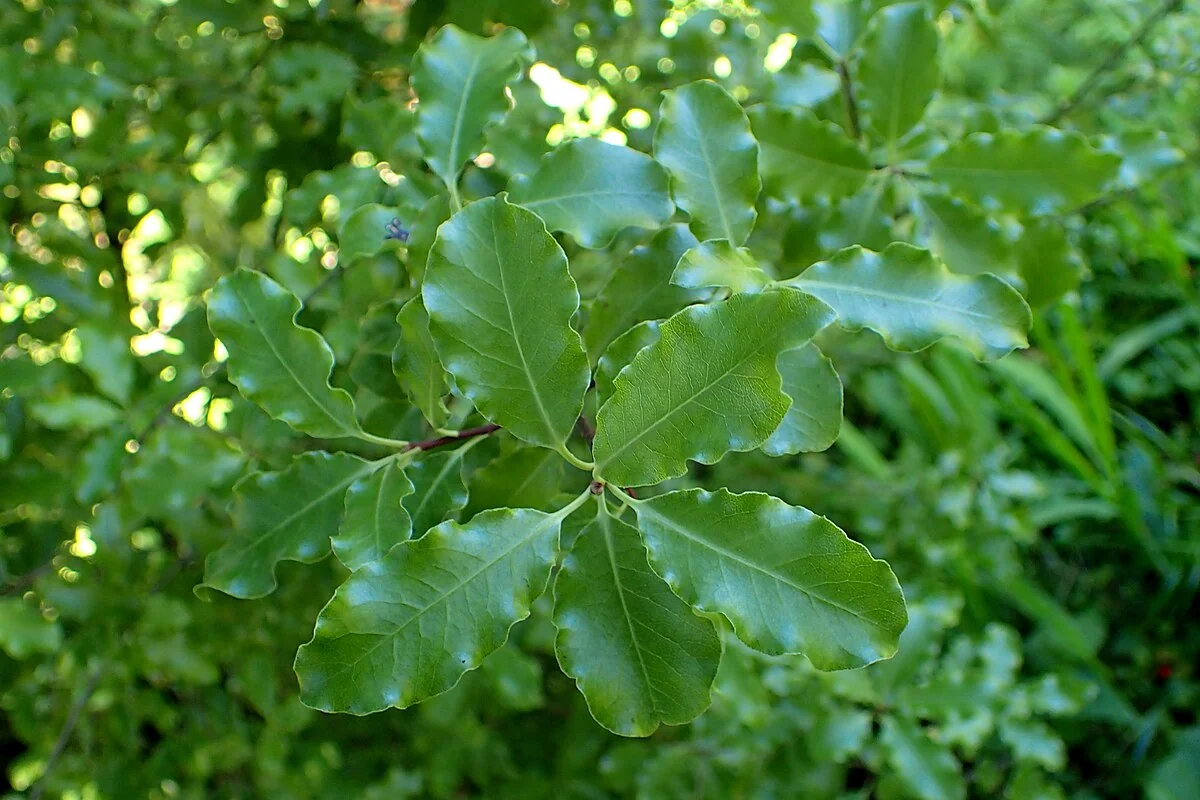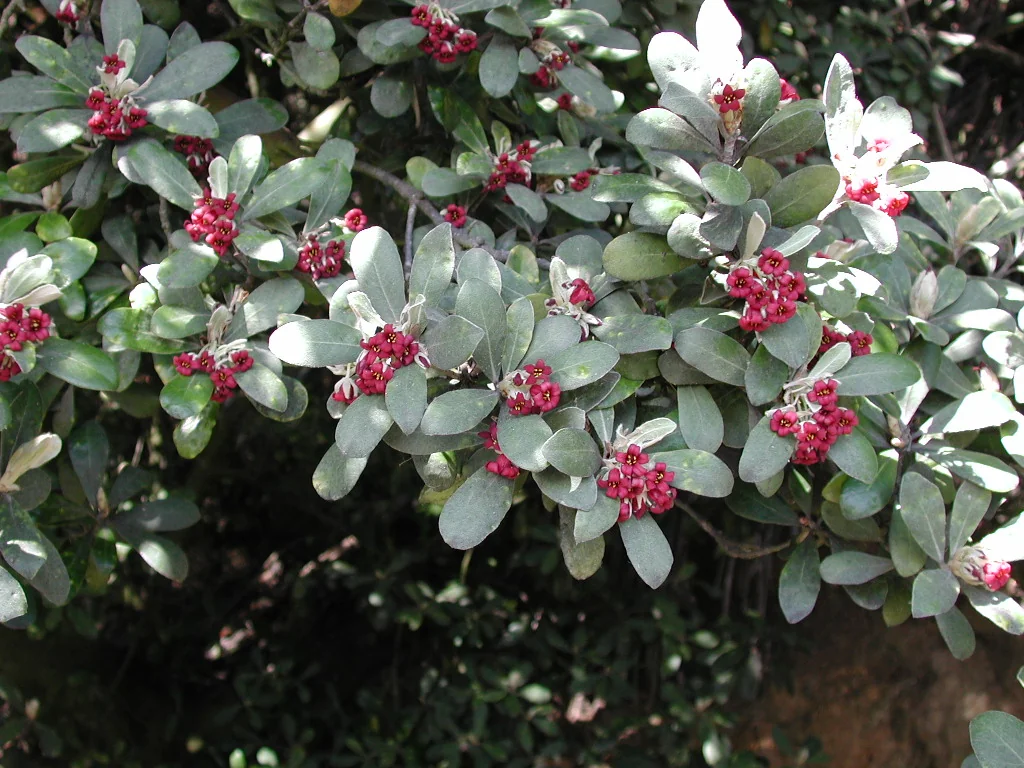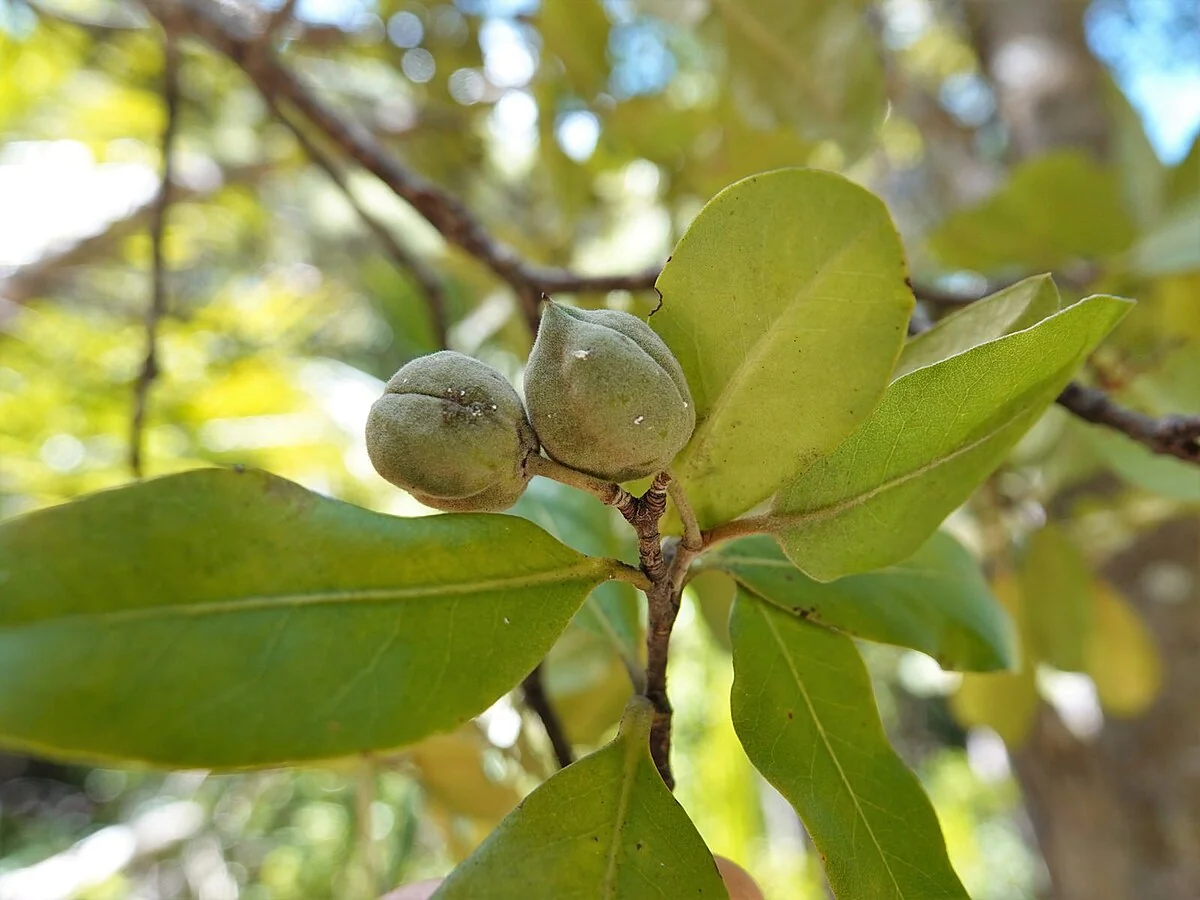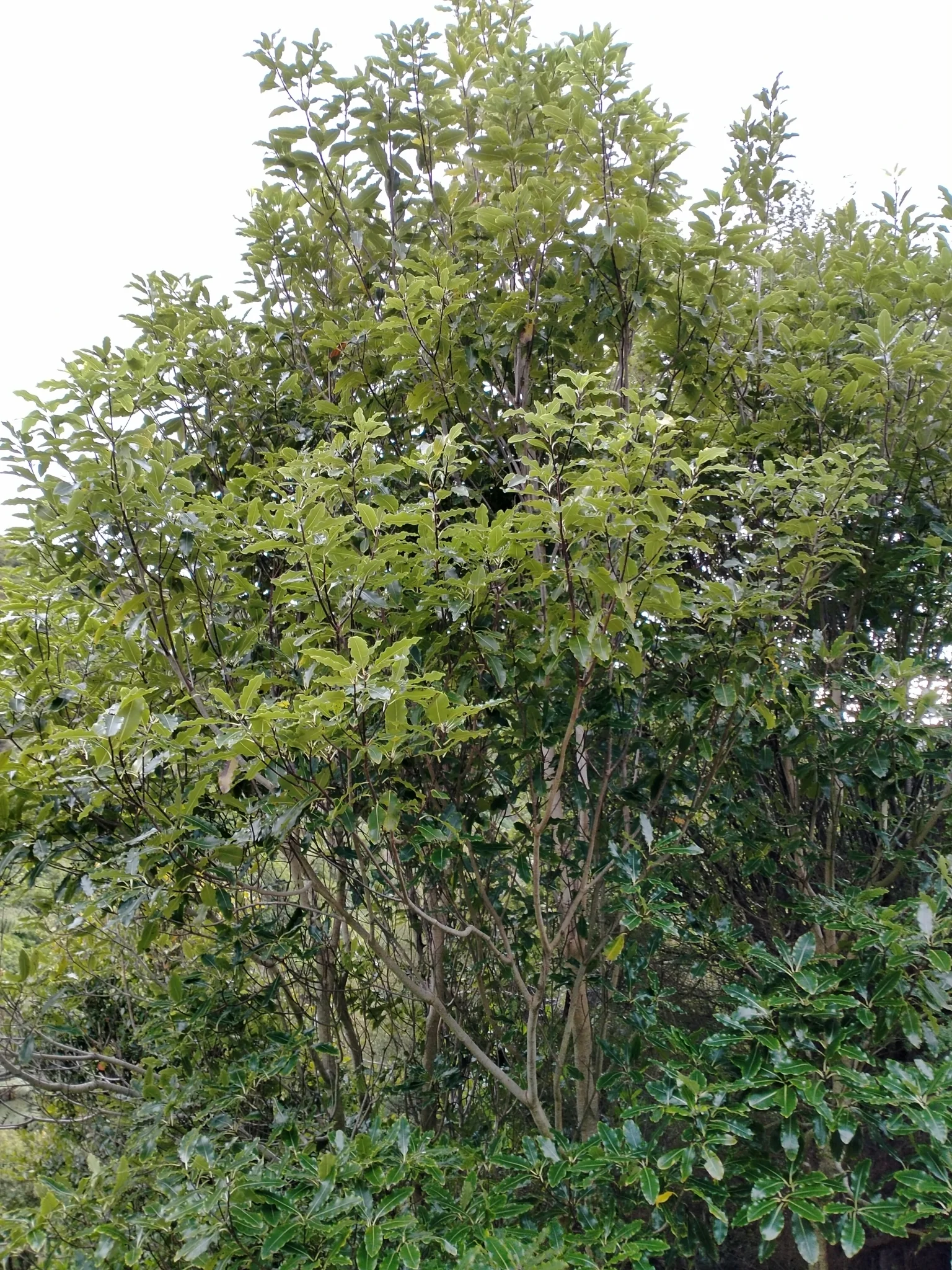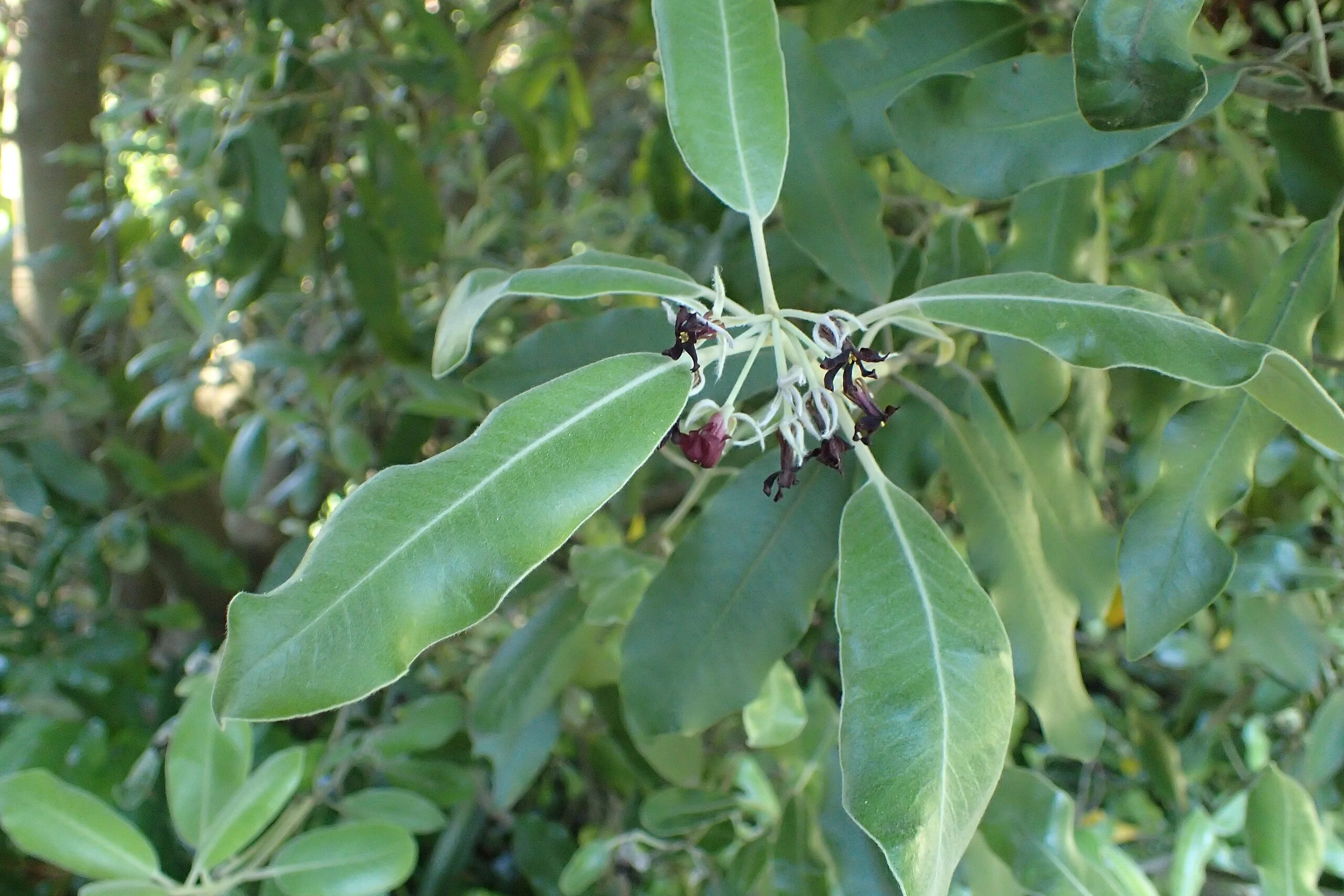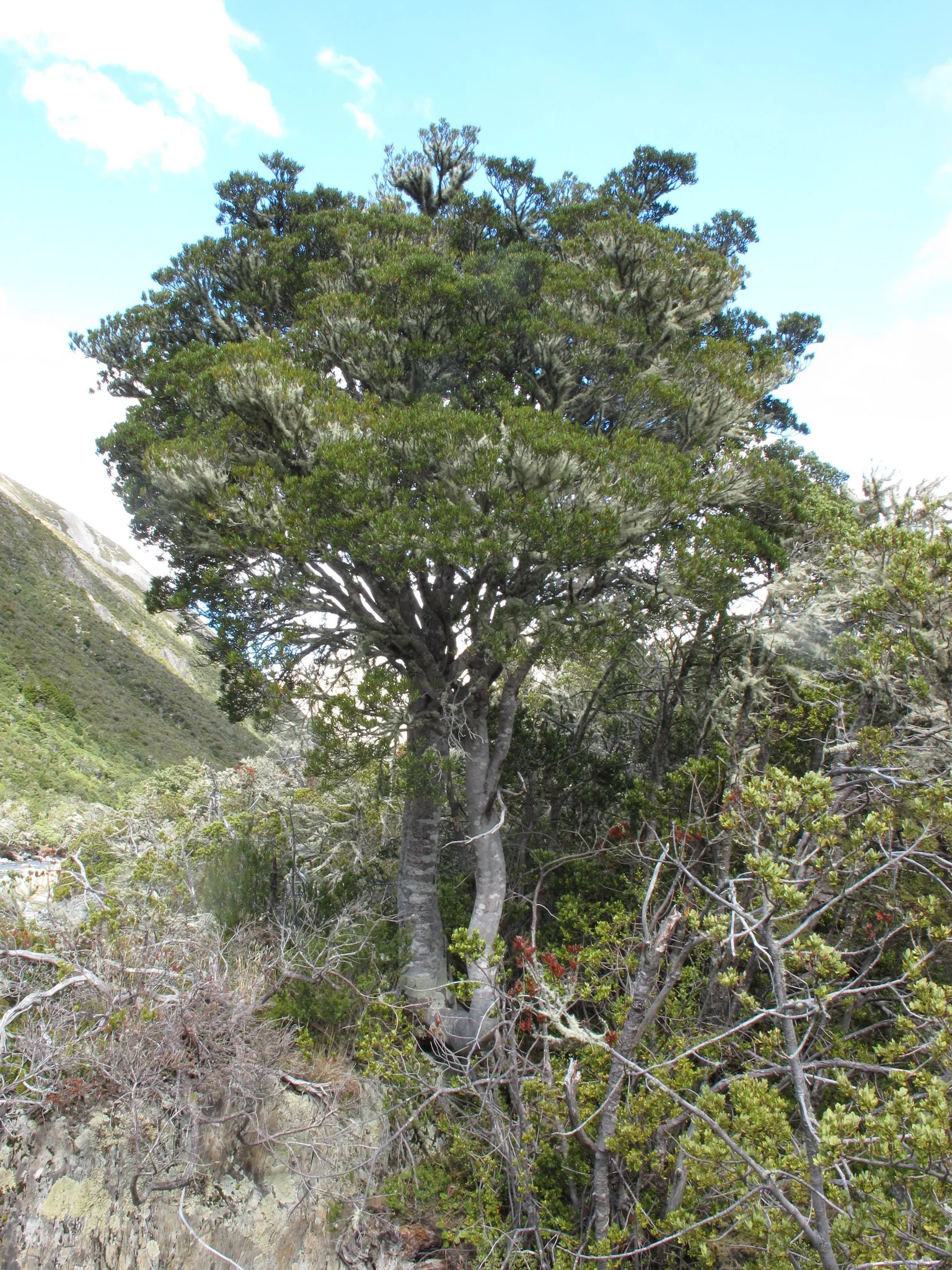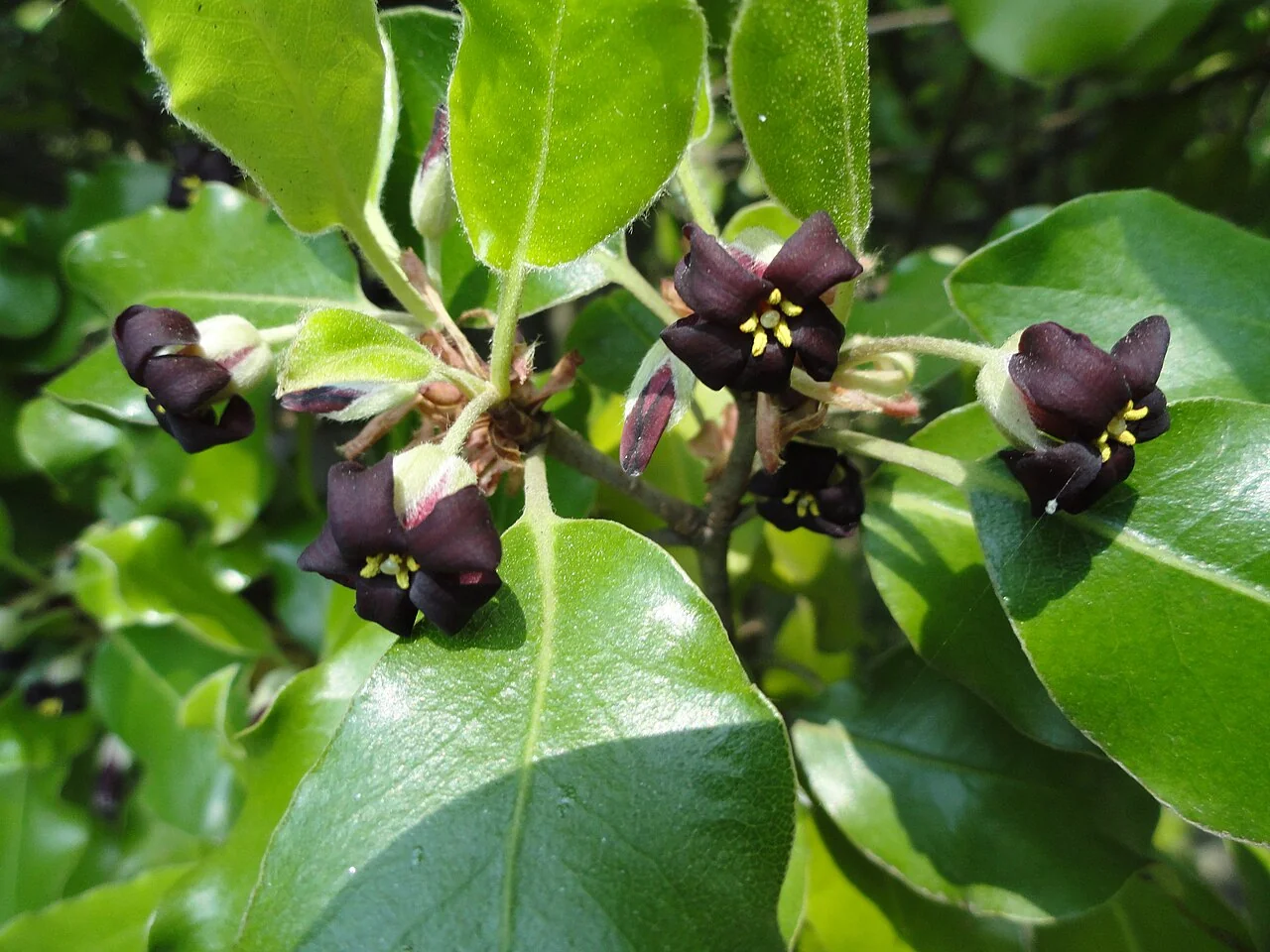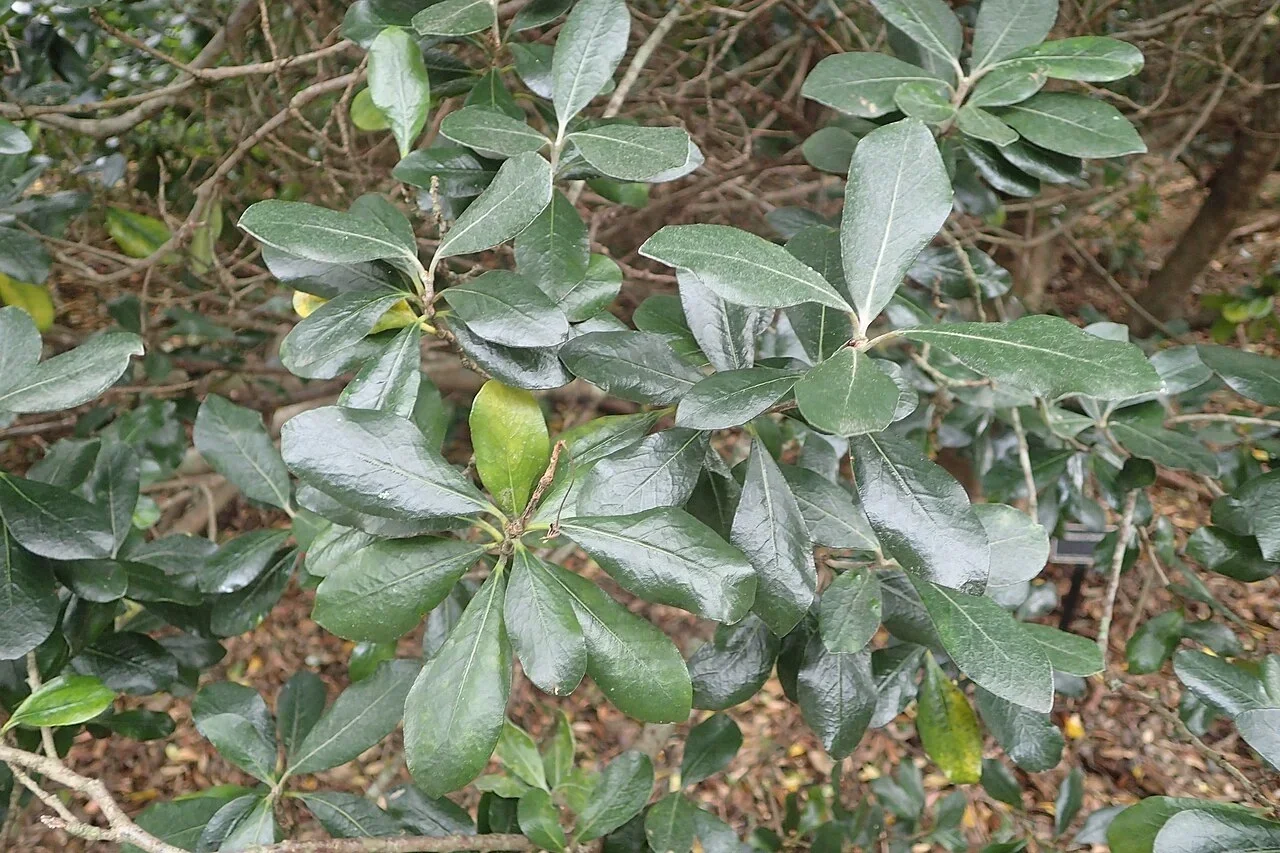
Fairchild's Kōhūhū
Pittosporum fairchildii
An uncommon North Island pittosporum forming a tidy shrub to small tree with glossy foliage and small, fragrant flowers. Suits well-drained, sheltered sites. Learn more in our native plants guide .

Plant Description
Botanical Features
Fairchild's Kōhūhū ( Pittosporum fairchildii ) is a species of plant endemic to New Zealand, specifically found on the Three Kings Islands. It is classified as a gynodioecious shrub to a small tree, typically growing 3 to 6 meters tall. Its leaves are dark green and leathery on the upper side, paler underneath, and elongated in shape. They are 5-7.5 cm long and sparsely covered in white fuzz when young, becoming mostly glabrous (smooth) with age. The branches are erect to spreading, grey-black, with young branchlets covered in a grey to brownish-grey tomentum (dense, matted hairs) that soon becomes smooth. In late spring, it produces small clusters of dark red to purple, chocolate, or white, daisy-like flowers, emerging in terminal clusters of 2-4 flowers during May to September. The fruit is a large, yellow-green capsule, about 2.5 cm wide, that splits into three or four sections to reveal dark, sticky seeds. These capsules are subglobose, 3-valved, and finely brown tomentose, maturing to pale yellow. It typically grows in coastal forest and on sheltered cliff faces, often found in the forest understory.
Quick Facts
Overview
| Scientific Name | Pittosporum Fairchildii |
|---|---|
| Height | 3-6 m |
| Spread | 2-4 m |
| Light | Sun to partial shade |
| Water Needs | Moderate; free-draining soils |
| Frost | Shelter when young |
| Frost Tolerance | Moderate; protect from severe frosts |
| Salt Tolerance | Moderate; tolerates some coastal exposure |
| Growth Rate | Moderate |
| Lifespan | Long-lived |
Climate Best Suited to
Regional climate suitability across major New Zealand cities.
Regional Suitability
| City | Climate Suitability |
|---|---|
| Whangārei | Ideal |
| Auckland | Ideal |
| Hamilton | Ideal |
| Tauranga | Ideal |
| Rotorua | Ideal |
| Gisborne | Ideal |
| New Plymouth | Ideal |
| Napier | Ideal |
| Whanganui | Ideal |
| Palmerston North | Ideal |
| Wellington | Ideal |
| Nelson | Ideal |
| Christchurch | Ideal |
| Dunedin | Ideal |
| Invercargill | Ideal |
Natural Habitat
Fairchild's Kōhūhū ( Pittosporum fairchildii ) is a species of plant endemic to New Zealand, specifically found on the Three Kings Islands. Its natural habitat includes coastal forests and sheltered cliff faces, where it is typically found in the forest understory or occasionally in open petrel scrub.
Distribution:
- Three Kings Islands Endemic: This species is exclusively found on the Three Kings Islands, a group of islands off the northern coast of New Zealand. It is known from the North East, Great (Manawatāwhi), South East, and West islands of this group.
Preferred Conditions:
- Coastal Forests: It thrives in coastal forest environments, indicating its adaptation to maritime conditions.
- Sheltered Cliff Faces: It is often found on sheltered cliff faces, suggesting a preference for protected yet exposed sites.
- Forest Understory: It commonly grows in the forest understory, indicating its tolerance for dappled light and humid conditions.
- Open Petrel Scrub: Occasionally, it can be found in open petrel scrub, showcasing some adaptability to more open environments.
Conservation Status:
- "At Risk - Naturally Uncommon": Pittosporum fairchildii is classified as "At Risk - Naturally Uncommon," highlighting its restricted distribution and the importance of conservation efforts to protect this unique species and its habitat.
The specialized habitat of Fairchild's Kōhūhū on the Three Kings Islands underscores its unique ecological niche and its contribution to the distinct biodiversity of this isolated island group.
Plant Conservation
Pittosporum fairchildii , also known as Fairchild's kōhūhū, is endemic to New Zealand, specifically the Three Kings Islands.
Its conservation status Has Been Classified As:
- Vulnerable by the IUCN (International Union for Conservation of Nature) in 1998.
- Not threatened by the NZPCN in more recent assessments, but noted to qualify for "Range Restricted" status due to its small geographic area.
- Naturally Uncommon in 2017 and 2012 by the Flora of New Zealand.
Growing Requirements
Soil
Well-drained, moderately fertile soils; avoid prolonged waterlogging.
Light
Performs in full sun to partial shade depending on species.
Water
Keep evenly moist while establishing; reduce irrigation as roots develop.
Temperature
Hardy in most regions of Aotearoa once established.
For Fairchild's Kōhūhū ( Pittosporum fairchildii ), choose a site with sun to partial shade and soil that is well-drained, moisture-retentive. Incorporate composted organic matter to improve structure and drainage. Plant with the crown or root collar at soil level, then apply a 5-8 cm mulch to moderate temperature, conserve moisture, and suppress weeds. Protect young plants from extremes while establishing and consider the stated frost tolerance (seasonal) when siting near exposure or cold air drains.
Planting Guide
Fairchild's Kōhūhū is a unique and naturally uncommon native New Zealand plant, endemic to the Three Kings Islands. While it is a resilient species adapted to coastal conditions, successful cultivation requires attention to its specific needs to ensure its continued survival and thriving.
1. Site Selection:
- Light: Fairchild's Kōhūhū prefers full sun to partial shade. In its natural habitat, it often grows in the forest understory, suggesting it appreciates some protection from intense, direct sunlight, especially in hotter climates.
- Soil: It thrives in well-drained, moderately fertile soils. Good drainage is crucial to prevent root rot. It can tolerate a range of soil types, but avoid heavy, waterlogged conditions. Incorporating organic matter can improve soil structure and fertility.
- Shelter: As a coastal species, it tolerates some coastal exposure and wind. However, young plants may benefit from shelter from harsh winds and severe frosts.
2. Planting Instructions:
- Timing: The best time to plant is in spring or early autumn, allowing the plant to establish its root system before extreme weather conditions.
- Preparation: Dig a hole that is twice the width of the root ball and to the same depth. Gently remove the plant from its container, minimizing root disturbance.
- Placement: Plant at the same level as it was in the container. Backfill the hole with soil, gently firming it around the roots to remove air pockets.
- Watering: Water thoroughly immediately after planting to settle the soil.
3. Ongoing Care:
- Watering: Maintain consistent moisture during establishment, especially in the first year. Once established, it is relatively drought-tolerant but benefits from regular watering during dry periods.
- Mulching: Apply a layer of organic mulch around the base of the plant to retain moisture, suppress weeds, and regulate soil temperature.
- Fertilizing: A light application of a balanced, slow-release fertilizer in spring can support healthy growth, but avoid overfeeding.
- Pruning: Fairchild's Kōhūhū generally requires minimal pruning. Focus on removing dead or damaged branches and light shaping to encourage bushy development. Pruning is best done in late winter or early spring.
- Pests and Diseases: Monitor for common pests like aphids or scale insects. Ensure good air circulation to prevent fungal issues.
Ecosystem Notes
- Role: Evergreen mid-storey shrub providing nectar, pollen, and cover.
- Dispersal: Bird-dispersed capsules with sticky seeds.
- Associates: Grows with Coprosma , Griselinia , and coastal pōhutukawa forests.
Uses and Significance
Garden and Restoration
An uncommon North Island pittosporum forming a tidy shrub to small tree with glossy foliage and small, fragrant flowers. Suits well-drained, sheltered sites.
- Sheltered gardens
- Screening and native shrub borders
Raise Fairchild's Kōhūhū from seed collected when ripe, or by semi-hardwood cuttings set under intermittent mist. Use sharp, disease-free material and maintain moderate warmth and bright, indirect light for rooting.
Landscaping Ideas
Sheltered Evergreen for Structure
- Screening: Clips lightly into a tidy screen in warm, frost-free gardens.
- Courtyards: Suits protected courtyards with reflective warmth and good drainage.
- Wildlife: Flowers and fruit support insects and birds in mixed native plantings.
Seasonal Care Calendar
Spring
- Plant and mulch
- Protect new growth from weeds
Summer
- Deep watering in drought
- Monitor pests
Autumn
- Light formative pruning
- Top up mulch
Winter
- Plant eco-sourced stock
- Stake in windy sites
Pruning and Maintenance
Techniques and Timing
Generally minimal; formative work when young and removal of damaged wood.
Prune Fairchild's Kōhūhū lightly to maintain structure; remove damaged shoots and avoid hard cuts on older wood.
How to Grow Fairchild's Kōhūhū
Fairchild's Kōhūhū is an uncommon North Island pittosporum forming a tidy shrub to small tree with glossy foliage and small, fragrant flowers. This resilient and ecologically important plant adds a touch of natural elegance and year-round interest to any landscape, showcasing the rich biodiversity of New Zealand's forests. Understanding its propagation methods is key to successfully growing this delightful species.
From Seed
Propagating Fairchild's Kōhūhū from fresh seed is a viable method, though the sticky coating around seeds should be removed as it acts as a germination inhibitor. Collect ripe capsules when they split (January-April). Extract black seeds and remove sticky coating thoroughly. Sow fresh seeds immediately in a well-draining seed-raising mix. Maintain consistent moisture in the seed tray and provide bright, indirect light. Germination may be slow, so patience is required. Transplant seedlings once they are large enough to handle.
From Cuttings
Semi-hardwood cuttings are a reliable method for propagating Fairchild's Kōhūhū, ensuring that new plants retain the exact characteristics of the parent. Take 10-15 cm cuttings from current season's growth in late summer to early autumn. Select semi-hardwood material (not too soft, not fully hard). Remove lower leaves, keeping 2-3 leaves at the top. Dip in rooting hormone for better success rates. Plant in a well-draining propagation mix. Maintain humidity and provide bright, indirect light. Roots typically develop within 6-12 weeks. Once rooted, the new plants can be potted on and grown in a sheltered environment until they are ready for planting.
Pests and Diseases
Common Problems and Solutions
Fairchild's Kōhūhū is generally robust but may be affected by sap-sucking insects and occasional foliar disease. The pittosporum psyllid can cause leaf cupping and distortion, especially on young growth; prune out badly affected tips and encourage vigorous regrowth. Soft scale and mealybugs sometimes colonise sheltered plants, leading to sooty mould on honeydew deposits - wash foliage and, if needed, treat with a light horticultural oil during mild weather. Avoid prolonged overhead wetting to reduce leaf-spot incidence, ensure good air movement around the canopy, and favour free-draining soils to prevent root stress in winter.
Cultural Significance
Traditional Uses and Values
Pittosporum fairchildii , also known as Fairchild's kōhūhū, is a species of plant endemic to New Zealand, specifically found on the remote Three Kings Islands. While the plant is named in honor of Captain J. Fairchild, a 19th-century seaman, there is no widely documented specific cultural significance or traditional uses attributed directly to Pittosporum fairchildii in standard references.
The broader Pittosporum genus in New Zealand does hold some cultural relevance. For instance, fragrant Pittosporum species like Pittosporum eugenioides (tarata or lemonwood) were sought after by Māori for use as scent or body lotion, with their resinous sap and crushed leaves mixed with plant oils. However, these general uses for the genus are not specifically linked to Pittosporum fairchildii . Its restricted distribution to the Three Kings Islands may contribute to the lack of extensive documented cultural practices associated with this particular species.
Bonus Tip
Expert Growing Advice
Fairchild's Kōhūhū is endemic to the Three Kings Islands. It was named in honor of Captain J. Fairchild, a 19th-century seaman. This species is unique for its dark red to nearly black flowers and its fruit, which splits into three or four sections to reveal dark, sticky seeds.
